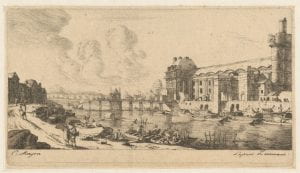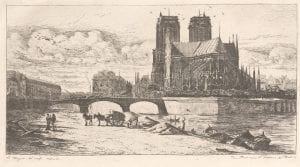Charles Meryon and the French etching revival
By the early 19th century in Europe, the intaglio technique of etching had fallen out of popularity in the graphic arts. Etching was a popular printmaking technique during the 16th and 17th centuries, with artists such as Rembrandt and Dürer regularly experimenting with the method. To create an etching, the printmaker coats a metal plate (traditionally copper) with an acid-resistant ‘ground’ before drawing their design through the ground with a sharp tool. Once the design is drawn, the plate is immersed in acid and the chemical reactions between the acid and the metal results in those areas unprotected by the ‘ground’ leaving behind clear lines. After cleaning the ‘ground’ off the plate, the printmaker applies ink to the incised lines and then transfer the design onto paper.
During the early 19th century, etching was employed as a reproductive process, and it consequently became closely associated with ideas of mass production and industry. In spite of this, a number of artists continued to pursue the medium. French artists and printmakers persevered with etching throughout the first half of the 19th century, and by the 1860s, a full-scale movement was underway that sought the contemporary revival of the technique [1].

Among these revivalist artists was Charles Meryon, born in Paris in 1821 [2]. He was a key figure in the French etching revival and produced 102 etchings in his lifetime [3]. Perhaps the greatest of these were his ‘Paris’ etchings, which brilliantly and meticulously showcased the full capabilities of the technique and successfully brought etching back into the high esteem of both collectors and critics [4]. Meryon’s etchings of Paris demonstrate—aside from astoundingly detailed views of the city—his painstaking approach to craftsmanship and artistry. His mastery over shadows and perspective, for example, indicates his commitment to technical refinement and careful study.
For Meryon, the choice of paper and ink was extremely important, and he was said to have been equally diligent in the processes of inking and wiping his plates [5]. It was precisely this sort of attentiveness to processes and details that characterised the approaches of the artists of this revival. With their innovation and dedication to artistry and methods, Meryon and his peers directly challenged the perception of etching as a mass produced, reproductive, and unoriginal technique. In his etchings of Paris, we can fully appreciate the endless possibilities of the method.

During the late 19th century, the revival had spread to the United Kingdom, America and beyond. The efforts of Meryon and his peers influenced numerous artists across the globe, including Lionel Lindsay, David Young Cameron, John McNeil Whistler and Muirhead Bone [6]. From humble beginnings came a new age for etching that would persist with remarkable popularity until well into the 20th century.
The Baillieu Library print collection holds five of Meryon’s etchings, three of which belong to his etchings of Paris series.
Jasmine Penman
Research Assistant Intern
References and further reading
[1] Britany Salsbury ‘The Etching Revival in Nineteenth-Century France’. Heilbrunn Timeline of Art History, New York: The Metropolitan Museum of Art, September 2014.
[2] Harold J. L. Wright, ’Three Master Etchers: Rembrandt, Meryon, Whistler: Lecture II. The Etch-ings of Charles Meryon (1821-1868)’, Journal of the Royal Society of Arts, Vol 78, September 1930, p. 1085.
[3] Wright, ‘The Etchings of Charles Meryon’, September 1930, p. 1084.
[4] James D. Burke, ‘Notes on Meryon’, The Print Collector’s Newspaper, Vol 5, September-October 1974, p. 84.
[5] Jacobus van Breda, ‘Charles Meryon: Paper and Ink’, Art in Print, Vol 3, September-October 2013, p. 17.
[6] Jacobus van Breda, “Charles Meryon: Paper and Ink”, September-October 2013, p. 21.
Leave a Reply